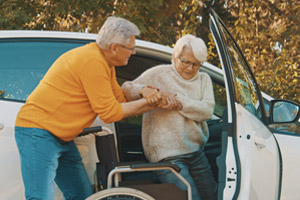Attention All Drivers: Passenger Loading and Unloading Safety Tips
by Madison Christian
April 2024
Most daily activities require transportation: getting groceries, having coffee with friends, checking the local farm crops, and attending medical appointments are only the basics for everyday living. For North Dakotans of any age, achy joints and stiff muscles can make getting in and out of a car or other vehicle challenging. Occupational therapists have tips and tricks to make these transfers easier and safer.
 The first tip for
getting into and out of the car safely is don't move too
fast. Like driving on icy roads, accidents happen when
rushing. Also important is extra caution when walking on
a slippery driveway or the uneven ground that leads up to
a vehicle.
The first tip for
getting into and out of the car safely is don't move too
fast. Like driving on icy roads, accidents happen when
rushing. Also important is extra caution when walking on
a slippery driveway or the uneven ground that leads up to
a vehicle.
The next tip benefits folks of all age groups, especially those with limited flexibility: Feel the car's seat on the back of the legs before sitting. Back up slowly towards the vehicle's seat with assistance from a walker, cane, or a helping hand for stability.
Once the legs are touching the car seat, the next tip is two-fold. First, with the legs still on the outside of the car, push up with the arms to lift the bottom onto the car seat and scoot back into the innermost, upper corner of the seat. This step provides leg clearance between the car door and the seat. Avoid "plopping" into the seat as it can put strain on the muscles and joints.
Once the bottom is in the seat, next it's time to bring the legs into the vehicle. Swing both legs over, utilizing assistance from the arms or another person if needed. A long scarf can also help by hooking around the soles of the shoes to hoist the legs over the edge of the vehicle. If needed, grab onto a non-moving surface or object during this step for stability, such as a grab handle located in the car.
Safety getting out of the car is just as important as getting in the car and similar tips apply. Go slow. If needed, use assistance from another person or a long scarf to swing the legs over the edge of the vehicle. Make sure both feet are planted firmly on the ground before standing upright. Push up with one or both arms from the car seat to fully stand. If assisting, stand close, but also bend knees and hips like sitting in a chair, keep the back straight, and stand up at the same time as the person being helped.
The final tip is for everyone: Communicate! If doing the assisting, provide a brief outline of the steps so that everyone knows what to expect. For example, say, "We will take our time and back up towards the car seat. Then, I will assist you by lifting your legs over the edge." It's also important for the person being helped to speak up, such as saying, "Hold on, my bottom isn't completely on the seat yet," or communicating if discomfort occurs, such as, "Can we stop for a second? This is hurting my lower back."
Folks of all ages need to be able to safely complete their travel-related everyday activities. Remember to go slow, touch the seat with the back of the legs, sit and then swing the legs in or out, communicate, and enjoy the ride.
About the Author
 Madison Christian is a 3rd-year
student in the University of North Dakota School of
Medicine & Health Sciences Occupational Therapy doctorate
program. As a participant in the patient care experiences
offered in Northwood, Christian also chose to participate
in the school's Targeted Rural Health Education program,
or TRHE. The program focuses on teaching student
healthcare professionals the importance of rural
newspapers as a way to share health information with
their rural community members. The information is not for
diagnosis or treatment and should not be used in place of
previous medical advice provided by a licensed
practitioner.
Madison Christian is a 3rd-year
student in the University of North Dakota School of
Medicine & Health Sciences Occupational Therapy doctorate
program. As a participant in the patient care experiences
offered in Northwood, Christian also chose to participate
in the school's Targeted Rural Health Education program,
or TRHE. The program focuses on teaching student
healthcare professionals the importance of rural
newspapers as a way to share health information with
their rural community members. The information is not for
diagnosis or treatment and should not be used in place of
previous medical advice provided by a licensed
practitioner.
